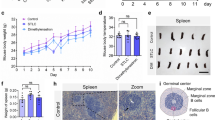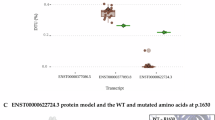Abstract
Microcephaly with or without chorioretinopathy, lymphoedema, or mental retardation (MCLMR) (MIM No.152950) is a rare autosomal dominant condition for which a causative gene has recently been identified. Mutations in the kinesin family member 11 (KIF11) gene have now been described in 16 families worldwide. This is a review of the condition based on the clinical features of 37 individuals from 22 families. This report includes nine previously unreported families and additional information for some of those reported previously. The condition arose de novo in 8/20 families (40%). The parental results were not available for two probands. The mutations were varied and include missense, nonsense, frameshift, and splice site and are distributed evenly throughout the KIF11 gene. In our cohort, 86% had microcephaly, 78% had an ocular abnormality consistent with the diagnosis, 46% had lymphoedema, 73% had mild-moderate learning difficulties, 8% had epilepsy, and 8% had a cardiac anomaly. We identified three individuals with KIF11 mutations but no clinical features of MCLMR demonstrating reduced penetrance. The variable expression of the phenotype and the presence of mildly affected individuals indicates that the prevalence may be higher than expected, and we would therefore recommend a low threshold for genetic testing.
Similar content being viewed by others
Log in or create a free account to read this content
Gain free access to this article, as well as selected content from this journal and more on nature.com
or
References
Feingold M, Bartoshesky Λ : Microcephaly, lymphoedema, and chorioretinal dysplasia: a distinct syndrome? Am J Med Genet 1992; 43: 1030–1031.
Ostergaard P, Simpson MA, Mendola A et al: Mutations in KIF11 cause autosomal-dominant microcephaly variably associated with congenital lymphoedema and chorioretinopathy. Am J Hum Genet 2012; 90: 56–62.
Connell FC, Gordon K, Brice G et al: The classification and diagnostic algorithm for primary lymphatic dysplasia: an update from 2010 to include molecular findings. Clin Genet 2013; 84: 303–314.
Baraitser M : Microcephaly; in The genetics of Neurological Disorders 2nd edn. Oxford: Oxford Medical Publications, 1990; vol 18: pp 26–33.
Woods CG, Parker A : Investigating microcephaly. Arch Dis Child 2013; 0: 1–7.
Abuelo D : Microcephaly syndromes. Semin Pediatr Neurol 2007; 14: 118–127.
Vasudevan PC, Garcia-Minaur S, Botella MP, Perez-Aytes A, Shannon NL, Quarrell OWJ : Microcephaly-lymphoedema-chorioretinal dysplasia: three cases to delineate the facial phenotype and review of the literature. Clin Dysmorphol 2005; 14: 109–116.
Dolk H : The predictive value of microcephaly during the first year of life for mental retardation at seven years. Dev Med Child Neurol 1991; 33: 974–983.
Trzupek KM, Falk RE, Demer JL, Weleber RG : Microcephaly with chorioretinopathy in a brother–sister pair: evidence for germ line mosacism and further delineation of the ocular phenotype. Am J Med Genet A 2007; 143A: 1218–1222.
Custer DA, Vezina G, Vaught DR et al: Neurodevelopmental and neuroimaging correlates in nonsyndromal microcephalic children. J Dev Behav Pediatr 2000; 21: 12–18.
Pastora N, Peralta J, Canal-Fontcuberta I et al: Microcephaly-lymphedema-chorioretinal dysplasia associated with pachymicrogyria and atrophy of the cerebellar vermis: an integration of brain-ocular migration disorders. Ophthalmic Genet 2012; 33: 116–118.
Lee BJ, Kim JH, Yu YS : Lissencephaly and mild cerebellar vermis hypoplasia in a case of microcephaly and chorioretinal dysplasia. Ophthalmic Genet 2010; 31: 89–93.
Casteels I, Devriendt K, Leys A et al: Autosomal dominant microcephaly-lymphoedema-chorioretinal dysplasia syndrome. Br J Ophthalmol 2001; 85: 496.
Puffenberger EG, Jinks RN, Sougnez C et al: Genetic mapping and exome sequencing identify variants associated with five novel diseases. PLoS One 2012; 7: e28936.
Abdel-Salam GM, Halasz AA, Czeizel AE : Association of epilepsy with different groups of microcephaly. Dev Med Child Neurol 2000; 42: 760–767.
Hordijk R, van de Logt F, Houtman WA, van Essen AJ : Chorioretinal dysplasia-microcephaly-mental retardation syndrome: another family with autosomal dominant inheritance. Genet Couns 1996; 7: 113–122.
Atchaneeyasakul LO, Linck L, Weleber RG : Microcephaly with chorioretinal degeneration. Ophthalmic Genet 1998; 19: 39–48.
Jarmas AL, Weaver DD, Ellis FD, Davis A : Microcephaly, microphthalmia, falciform retinal folds, and blindness. A new syndrome. Am J Dis Child 1981; 135: 930–933.
Young ID, Fielder AR, Simpson K : Microcephaly, microphthalmos and retinal folds: report of a family. J Med Genet 1987; 24: 172–174.
Limwongse C, Wyszynski RE, Dickerman LH, Robin NH : Microcephaly-lymphoedema-chorioretinal dysplasia: a unique genetic syndrome with variable expression and possible characteristic facial appearance. Am J Med Genet 1999; 86: 215–218.
Milroy WF : An undescribed variety of heritable oedema. NY Med J 1892; 56: 505–508.
Eventov-Friedman S, Singer A, Shinwell ES : Microcephaly, lymphoedema, chorioretinopathy and atrial septal defect: a case report and review of the literature. Acta Paediatr 2009; 98: 758–759.
Zhao Q, Ma X, Jia B, Huang G : Prevalence of congenital heart disease at live birth: an accurate assessment by echocardiographic screening. Acta Paediatr 2013; 102: 397–402.
McKusick VA, Stauffer M, Knox DL, Clark DB : Chorioretinopathy with hereditary microcephaly. Arch Ophthal 1966; 75: 597–600.
Strenge S, Froster UG : Microcephaly-lymphoedema syndrome: report of a family with short stature as an additional feature. Am J Med Genet 1998; 80: 506–509.
Hazan F, Ostergaard P, Ozturk T et al: A novel KIF11 mutation in a Turkish patient with microcephaly, lymphoedema, and chorioretinal dysplasia from a consanguineous family. Am J Med Genet A 2012; 158A: 1686–1689.
Prattichizzo C, Macca M, Novelli V et al: Mutational spectrum of the oral-facial-digital type I syndrome: a study on a large collection of patients. Hum. Mutat 2008; 29: 1237–1246.
Winter RM, Baraitser M : London Medical Databases: Winter Baraitser Dysmorphology Database Version 1.0.24. Oxford: Oxford University Press, 2007.
Acknowledgements
We thank the families for agreeing to the publication of their clinical details and photographs. We also thank the British Heart Foundation (PG/10/58/28477 to PO) and (FS/11/40/28739 to KG), Sheffield Children’s Hospital Charity, and the NIHR Biomedical Research Centre at the Moorfields Eye Hospital and the Institute of Ophthalmology for supporting the research.
Author information
Authors and Affiliations
Corresponding author
Ethics declarations
Competing interests
The authors declare no conflict of interest.
Additional information
ETHICS
The Ethical approval for this work was obtained from the South West London Research Ethics Committee (REC Ref: 05/Q0803/257) and the North Sheffield Research Ethics Committee (REC Ref: 05/Q2308/156).
Rights and permissions
About this article
Cite this article
Jones, G., Ostergaard, P., Moore, A. et al. Microcephaly with or without chorioretinopathy, lymphoedema, or mental retardation (MCLMR): review of phenotype associated with KIF11 mutations. Eur J Hum Genet 22, 881–887 (2014). https://doi.org/10.1038/ejhg.2013.263
Received:
Revised:
Accepted:
Published:
Issue date:
DOI: https://doi.org/10.1038/ejhg.2013.263
Keywords
This article is cited by
-
Kinesin-5 Eg5 is essential for spindle assembly, chromosome stability and organogenesis in development
Cell Death Discovery (2022)
-
Autosomal recessive diseases among the Athabaskans of the southwestern United States: anthropological, medical, and scientific aspects
Journal of Applied Genetics (2021)
-
Congenital focal abnormalities of the retina and retinal pigment epithelium
Eye (2020)
-
An interphase pool of KIF11 localizes at the basal bodies of primary cilia and a reduction in KIF11 expression alters cilia dynamics
Scientific Reports (2020)
-
Clinical and genetic characteristics of 251 consecutive patients with macular and cone/cone-rod dystrophy
Scientific Reports (2018)



